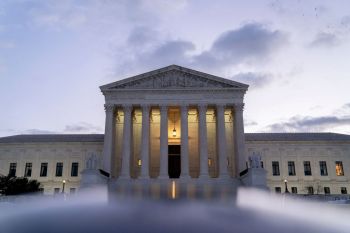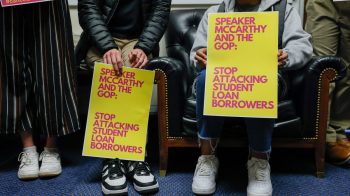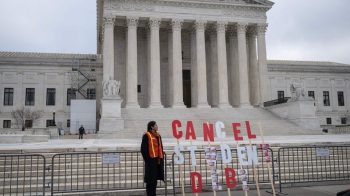
Would canceling $10,000 in student debt really help that much?
Share Now on:
Would canceling $10,000 in student debt really help that much?

About 42 million Americans hold a total of $1.6 trillion in student loan debt. The hot-button issue of student loan cancelation, or forgiveness, has once again been top of mind after Sen. Chuck Schumer said in an interview that President-elect Joe Biden could wipe out the first $50,000 of federally-held debt “with the pen as opposed to legislation” — in other words, with an executive order.
Schumer and Sen. Elizabeth Warren co-authored a resolution in September calling for the next president to do just that. The senators cited analysis from the Legal Services Center of Harvard Law School which says that because the Department of Education gives out the loans, the Secretary of Education has the power to forgive them. And since 92% of student loans are held by the Department of Education, that could help a lot of borrowers.
When asked about his plans for canceling student debt last week, Biden answered by expressing his support for pandemic relief legislation proposed by House Democrats that would immediately forgive $10,000 of student loans. Not exactly the $50,000 Schumer and Warren are calling for, but according to some economists, $10,000 would help a lot of the most vulnerable student loan holders.
The impact of $10,000 of student debt forgiveness
Biden’s platform states that “student debt both exacerbates and results from the racial wealth gap.” Of the 1 in 5 Americans with student loan debt, a disproportionate number are Black. Nick Hillman, associate professor of educational leadership and policy analysis at University of Wisconsin-Madison, points out that data shows in communities of color, 17% of borrowers are in default and their median loan is $9,067.
“Canceling a relatively small amount of debt could go a long way for helping struggling borrowers and people of color in particular,” he said.
Natalie Bachas, an assistant professor of economics at Princeton University, said there’s not necessarily a correlation between the amount of outstanding debt and a person’s ability to pay.
“Sometimes you can actually find that people who have lower balances can have a lot of difficulty during repayment,” she said.
“If you think of the typical borrower who holds $5,000 or $10,000 of student debt only, they typically went to community college, they may have dropped out, and consequently they don’t earn as much,” said Constantine Yannelis, assistant professor of finance at the University of Chicago Booth School of Business. A lot of the people who have high debt are high earners, he said, because they accrued that debt while pursuing higher degrees, like masters, medical and law degrees.
Arguments for and against student loan cancellation
Supporters say forgiving student loan debt would stimulate the economy, boost GDP, increase home purchases and free a generation of borrowers from financial burden taken on when they weren’t even old enough to purchase alcohol.
Detractors say if economic stimulus is the goal, there are better policies. Some economists also argue that $50,000 in relief is a regressive policy that would benefit those at an economic advantage. There is also a moral hazard argument that forgiving risky behavior, like taking out loans, encourages more risky behavior.
But the evidence for any of these arguments is limited, Hillman said.
“I wish that there was some research consensus here,” he said. “What I see — and what I get very frustrated by — is the poor data quality that we have on student loan debt just doesn’t allow us to answer these questions in convincing ways.”
“The effects are all speculative. It’s all hypothetical,” he added. “It’s hard to say what kind of impact this would have on individuals or the broader economy.”
There’s already a loan-forgiveness system in place
And Yannelis points out that there already is a system for forgiveness on federally-held loans — income-driven repayment. With this system, monthly payments are determined based on a borrower’s income, not the amount of debt. After 20 or 25 years, the remaining debt is forgiven. Currently, 27% of all federal loan borrowers are repaying direct loans through income-driven plans.
“So another way of targeting student loan forgiveness to lower income individuals is simply expanding the generosity of income-driven repayment,” he said. “And that would avoid the issue of giving loan forgiveness to people with MDs, JDs and MBAs who are earning quite high salaries.”
But income-based repayment is infamously complex, Bachas said. Borrowers have to first know about these programs, and then opt-in to them and renew their participation. The “hassle costs” are high. Also, the principle remains the same, and borrowers run the risk of accruing more interest in stretching out the maturity. Income-based repayments could help solve a liquidity problem in that borrowers have more cash in their pocket, Bachas said, but loan forgiveness could change borrower’s choices now and in the future.
In this way, Bachas said, a broad-brush policy might actually be the most effective.
“As an economist, you would always say ‘It’s always going to be more effective and more efficient to use a policy that has a lot more complexity or a lot more nuance to it,’” she said. “Having a more simple approach — like debt forgiveness — has benefits in that it’s more effective because it’s just a lot simpler for people to take advantage of.”
What about students in college now?
What would loan forgiveness do for students currently taking out loans to finance their education? “Nothing,” Hillman said.
“Forgiveness isn’t going to get at the root of high college costs,” Yannelis said.
And there is growing evidence that when you raise federal loan limits, colleges raise tuition almost one-to-one, Bachas said. “If there’s something in the longer term where the government can interact with the actual schools and say ‘You’re also somewhat on the line for this loan repayment,’ or something like that, I think that would be the right direction to go in,” she said.
So while $10,000 of forgiveness could actually do a lot to help the people who need it most right now, it’s clear comprehensive policy is crucial in solving crushing student debt going forward.
There’s a lot happening in the world. Through it all, Marketplace is here for you.
You rely on Marketplace to break down the world’s events and tell you how it affects you in a fact-based, approachable way. We rely on your financial support to keep making that possible.
Your donation today powers the independent journalism that you rely on. For just $5/month, you can help sustain Marketplace so we can keep reporting on the things that matter to you.


















